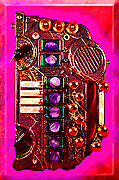a bender's guide
[circuit-bending] ![]()
a bender's guide
|
[exploring the art] |
|
| [circuit bending] [introduction] [tools] [parts] [exploring the art] [how it works] [direct wiring] [potentiometers] [capacitors] [photo resistors] [solar cells] [leds] [humidity sensors] [body-contacts] [reset switch] [line outputs] [other techniques] [cautions] [closing words] |
Before your first circuit-bending project, if you've never used the above equipment before, buy and build a beginner's electronic kit. An LED flasher, a digital clock, an integrated circuit noise maker... anything that will familiarize you with soldering, wire clipping and stripping, etc.... the basics of electronic circuit-building.
|
|
 Species Device |
||
|
||
| [continue] | ||
| [1] [2] [3] [4] [5] [6] [7] [8] [9] [10] [11] | ||
| [12] [13] [14] [15] [16] [17] [18] [19] |